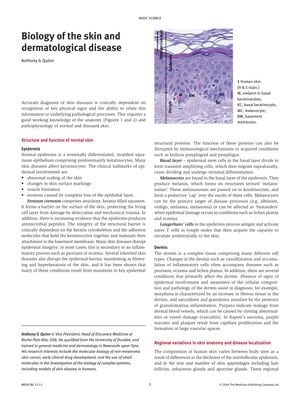Biology of the Skin and Dermatological Disease
December 2004
in “
Medicine
”
keratinocytes stratum corneum antimicrobial peptides basal layer melanocytes Langerhans' cells dermis psoriasis eczema lichen planus acne vulgaris discoid lupus erythematosus alopecia hirsutism hair cycle androgen-dependent androgen-independent skin's immune system host defense pathogenesis hair loss hair growth skin diseases immune system

TLDR Knowing how skin works and its diseases helps doctors diagnose and treat skin conditions better.
The document discusses the importance of understanding the anatomy and pathophysiology of normal and diseased skin for accurate diagnosis of skin diseases. It outlines the structure and function of the epidermis, including the role of keratinocytes, the stratum corneum, and the production of antimicrobial peptides. The document also describes the basal layer, melanocytes, and Langerhans' cells in the epidermis, as well as the complex nature of the dermis and its involvement in diseases like psoriasis, eczema, and lichen planus. It highlights regional variations in skin anatomy and how these contribute to disease localization, such as in acne vulgaris and discoid lupus erythematosus. Disorders of hair growth, including alopecia and hirsutism, are characterized by changes in the hair cycle, with conditions being androgen-dependent or androgen-independent. The skin's immune system is also discussed, emphasizing its role in host defense and the pathogenesis of skin diseases. The document suggests that understanding these biological aspects is crucial for diagnosing and treating skin diseases effectively.





